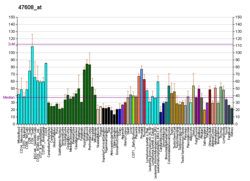| TJAP1 |
|---|
|
| Identifiers |
|---|
| Aliases | TJAP1, PILT, TJP4, tight junction associated protein 1 |
|---|
| External IDs | OMIM: 612658; MGI: 1921344; HomoloGene: 12534; GeneCards: TJAP1; OMA:TJAP1 - orthologs |
|---|
| Gene location (Human) |
|---|
 | | Chr. | Chromosome 6 (human)[1] |
|---|
| | Band | 6p21.1 | Start | 43,477,523 bp[1] |
|---|
| End | 43,506,556 bp[1] |
|---|
|
| Gene location (Mouse) |
|---|
 | | Chr. | Chromosome 17 (mouse)[2] |
|---|
| | Band | 17|17 C | Start | 46,568,777 bp[2] |
|---|
| End | 46,593,952 bp[2] |
|---|
|
| RNA expression pattern |
|---|
| Bgee | | Human | Mouse (ortholog) |
|---|
| Top expressed in | - secondary oocyte
- sural nerve
- C1 segment
- inferior ganglion of vagus nerve
- optic nerve
- inferior olivary nucleus
- left ovary
- gastrocnemius muscle
- right ovary
- body of uterus
|
| | Top expressed in | - muscle of thigh
- ventricular zone
- neural layer of retina
- lip
- vestibular sensory epithelium
- zygote
- gastrula
- yolk sac
- primary visual cortex
- epiblast
|
| | More reference expression data |
|
|---|
| BioGPS | 
 | | More reference expression data |
|
|---|
|
| Gene ontology |
|---|
| Molecular function | | | Cellular component | - cytoplasm
- cell junction
- endosome
- trans-Golgi network
- plasma membrane
- bicellular tight junction
- Golgi apparatus
| | Biological process | | | Sources:Amigo / QuickGO |
|
| Orthologs |
|---|
| Species | Human | Mouse |
|---|
| Entrez | | |
|---|
| Ensembl | | |
|---|
| UniProt | | |
|---|
| RefSeq (mRNA) | NM_001146016
NM_001146017
NM_001146018
NM_001146019
NM_001146020
|
|---|
NM_080604
NM_001350561
NM_001350562
NM_001350563
NM_001350564
NM_001350565
NM_001350566
NM_001350567
NM_001350568
NM_001350569
NM_001350570
NM_001394538
NM_001394539
NM_001394540
NM_001394541
NM_001394542
NM_001394543
NM_001394544
NM_001394545 |
| |
|---|
NM_001252473
NM_001252474
NM_001252475
NM_028751 |
|
|---|
| RefSeq (protein) | NP_001139488
NP_001139489
NP_001139490
NP_001139491
NP_001139492
|
|---|
NP_542171
NP_001337490
NP_001337491
NP_001337492
NP_001337493
NP_001337494
NP_001337495
NP_001337496
NP_001337497
NP_001337498
NP_001337499 |
| |
|---|
NP_001239402
NP_001239403
NP_001239404
NP_083027 |
|
|---|
| Location (UCSC) | Chr 6: 43.48 – 43.51 Mb | Chr 17: 46.57 – 46.59 Mb |
|---|
| PubMed search | [3] | [4] |
|---|
|
| Wikidata |
| View/Edit Human | View/Edit Mouse |
|



















